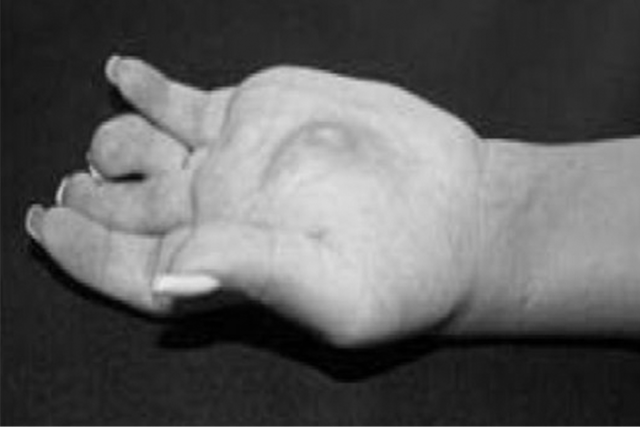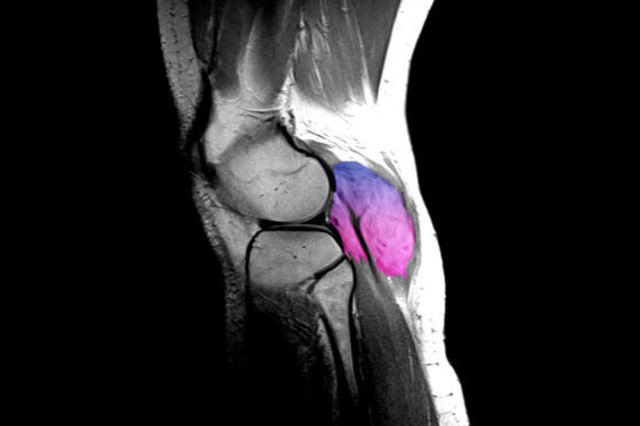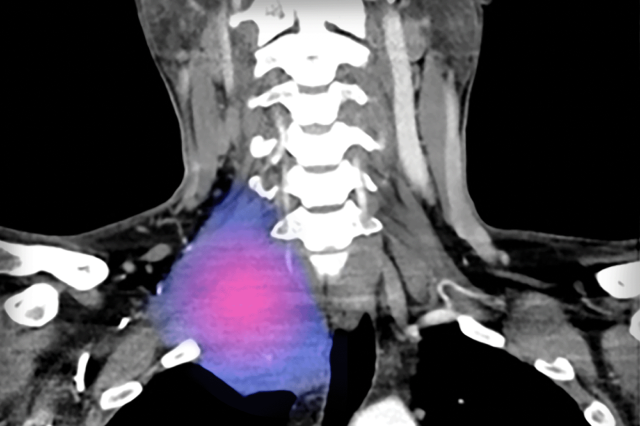Even though they do not metastasize, desmoid tumors often interfere with everyday activities and can be life-threatening1,2
Desmoid tumor characteristics:2,3,5,6
- Rare
- Locally aggressive
- Unpredictable clinical course
- Vital organs can be impacted
Desmoid tumors are associated with a potentially high and multifaceted burden of illness:4,*
- Pain
- Disfigurement
- Decreased physical function
In focus groups and interviews, patients reported that pain was the most debilitating symptom of desmoid tumors1,†
Examples of desmoid tumors and potential symptoms

Back
Large desmoid tumor (15 cm x 10 cm) proximal to the spine7
Image adapted from Cohen S, et al. World J Surg Oncol. 2008;6:28. Reused under Creative Commons License 2.0 (creativecommons.org/licenses/by/2.0). Image background changed to gray.

Hand
Desmoid tumor causing severe restriction in the flexion of the hand8
Image reproduced from Scaramussa FS, et al. SM J Orthop. 2016;2(3):1036. Reused under Creative Commons License 4.0 (creativecommons.org/licenses/by/4.0).

Knee
MRI scan showing desmoid tumor behind the right knee associated with electric paresthesias and reduced flexion9
Image adapted from Weschenfelder W, et al. Case Rep Surg. 2015;2015:262654. Reused under Creative Commons License 3.0 (creativecommons.org/licenses/by/3.0). False color added.

Neck
CT scan showing desmoid tumor in the right upper neck involving the brachial plexus associated with pain, numbness, and weakness in the right arm10
Image adapted from Styring E, et al. Am J Med Case Rep. 2019;7(3):36-40. Reused under Creative Commons License 4.0 (creativecommons.org/licenses/by/4.0). False color added.
Data from a Memorial Sloan Kettering/Desmoid Tumor Research Foundation patient-reported outcome (PRO) validation study that included patients with desmoid tumors (n=31, age range 20-68, 77% female). Patients participated in 60-minute qualitative phone interviews to provide their perspectives on disease symptoms and impact on their quality of life. The majority of the patients in this study were symptomatic (84%). Tumor site and type varied across patients. The concepts discussed during interviews were used to develop a draft patient-reported outcome scale, which was further refined in cognitive interviews of additional patients with desmoid tumors (n=15).4
Twenty-seven patients with desmoid tumors were interviewed from the Royal Marsden Hospital in the United Kingdom. Two focus groups and 13 interviews explored health-related quality of life issues and experiences of healthcare related to their desmoid tumors.1
CT, computed tomography; MRI, magnetic resonance imaging.
ICD-10-CM Codes for Desmoid Tumors
Location-specific ICD-10-CM codes for desmoid tumors went into effect on October 1, 2023. The codes can help you document location-specific desmoid tumor diagnoses in your patients.
Identifying the earliest signs of desmoid tumor progression is key for patient management
NCCN Clinical Practice Guidelines in Oncology (NCCN Guidelines®) recommendations for initiating treatment11,‡
- Symptoms
- Impairing or threatening in function
- Tumor growth documented on imaging (e.g., MRI or CT)
A course of ongoing observation is an appropriate option even for patients with disease progression, if the patient is minimally symptomatic and the anatomical location of the tumor is not critical. For tumors that are symptomatic, or impairing or threatening in function, patients should be offered therapy with the decision based on the location of the tumor and potential morbidity of the therapeutic option.11

The NCCN Guidelines® and Desmoid Tumor Working Group (DTWG) Guideline recommend evaluation and management of patients by a multidisciplinary team with expertise and experience in desmoid tumors prior to the initiation of a treatment plan.11,12
Desmoid tumor management is evolving

Clear margins are often challenging to achieve with surgery and may require extensive resection that can lead to additional pain and functional impairment.13-16

Surgery is no longer recommended by guidelines as first-line treatment for most clinical situations11,12
- Up to 77% recurrence rates after surgical resection of desmoid tumors15,17,§
- In a retrospective analysis, extremity, chest wall, and intra-abdominal desmoid tumors were associated with higher risk of recurrence than tumors located at other sites18
- Independent studies have reported desmoid tumor recurrence rates of up to 30% even with clear margins18-21
- Surgical trauma and growth factors released during wound healing may worsen desmoid tumors and promote recurrence14,15,22
- According to the NCCN Guidelines: In general, surgery is not considered a first-line treatment option for desmoid tumors, except in certain situations if agreed upon by a multidisciplinary tumor board11

Systemic therapies are recommended as a first-line treatment option for progressive, morbid, or symptomatic desmoid tumors, according to the NCCN Guidelines and Desmoid Tumor Working Group (DTWG) Guideline.11,12,‖ NCCN Guidelines include the following systemic therapy agents and regimens for the treatment of desmoid tumors (aggressive fibromatosis):11,¶
- Preferred regimens: nirogacestat (NCCN Category 1); sorafenib (NCCN Category 1); methotrexate and vinorelbine; methotrexate and vinblastine; imatinib; liposomal doxorubicin; doxorubicin +/- dacarbazine; pazopanib
- Useful in certain circumstances: sulindac or other NSAIDs, including celecoxib (for pain)
Systemic (medical) therapy is recommended as a first-line option across all desmoid tumor locations by the DTWG Guideline.12
Based on retrospective, observational data. Factors associated with local recurrence postsurgery include tumor location, age of the patient, tumor size, margin status, and prior recurrence.18,23
NCCN Guidelines also recommend ablation/embolization and definitive radiation therapy as first-line treatment options for progressive, morbid, or symptomatic desmoid tumors for certain patients.11
All recommendations are Category 2A unless otherwise indicated.11


